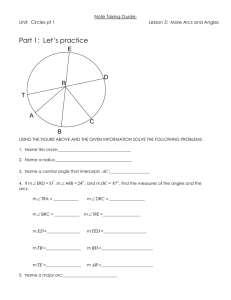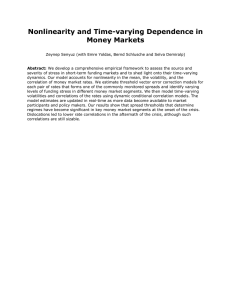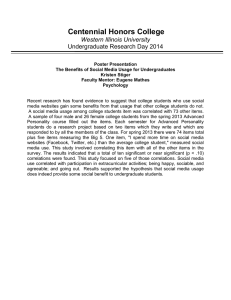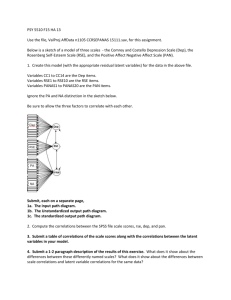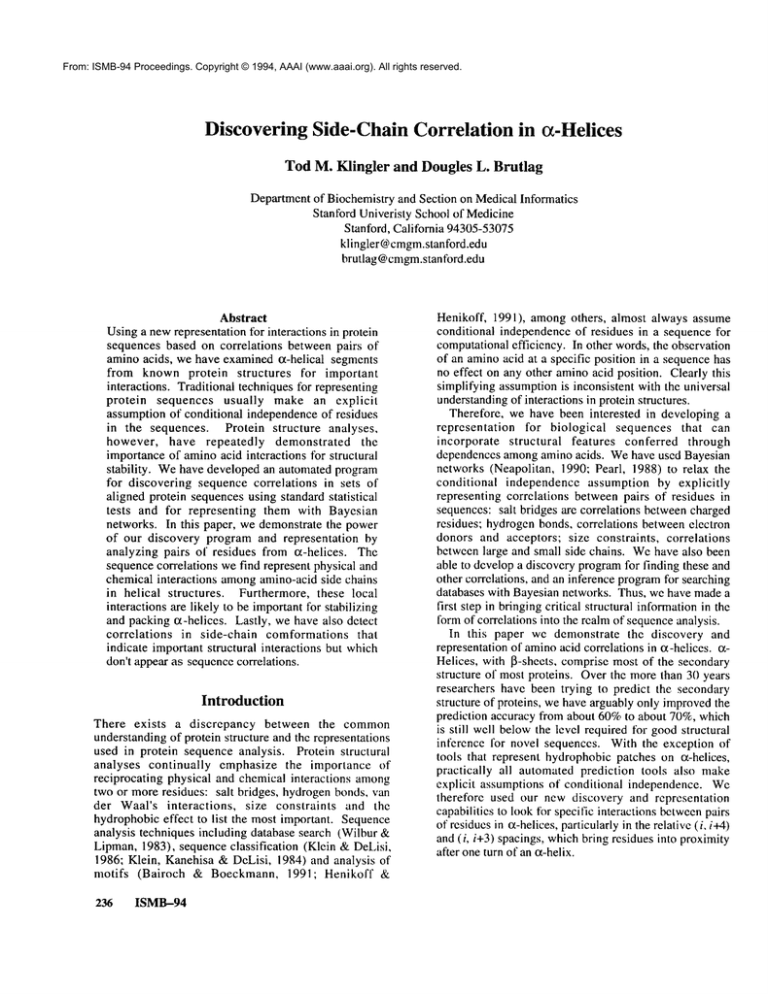
From: ISMB-94 Proceedings. Copyright © 1994, AAAI (www.aaai.org). All rights reserved.
Discovering Side-Chain Correlation in m-Helices
Tod M. Klingler
and Dougles L. Brutlag
Departmentof Biochemistry and Section on Medical Informatics
Stantbrd Univeristy School of Medicine
Stanford, California 94305-53075
klingler@ cmgm.stanford.edu
brutlag@cmgm.stanford.edu
Abstract
Usinga newrepresentation for interactions in protein
sequences based on correlations between pairs of
amino acids, we have examinedor-helical segments
from known protein structures
for important
interactions. Traditional techniques tbr representing
protein sequences usually make an explicit
assumption of conditional independence of residues
in the sequences. Protein structure analyses,
however, have repeatedly
demonstrated the
importance of aminoacid interactions tbr structural
stability. Wehave developed an automated program
for discovering sequence correlations in sets of
aligned protein sequences using standard statistical
tests and for representing them with Bayesian
networks. In this paper, we demonstrate the power
of our discovery program and representation by
analyzing pairs of residues from c~-helices. The
sequence correlations we find represent physical and
chemical interactions amongamino-acid side chains
in helical structures. Furthermore, these local
interactions are likely to be importantfor stabilizing
and packing s-helices. Lastly, we have also detect
correlations in side-chain comformations that
indicate important structural interactions but which
don’t appear as sequencecorrelations.
Introduction
There exists a discrepancy
between the common
understandingof protein structure and the representations
used in protein sequence analysis. Protein structural
analyses continually emphasize the importance of
reciprocating physical and chemical interactions among
two or more residues: salt bridges, hydrogenbonds, van
der Waal’s interactions,
size constraints and the
hydrophobic effect to list the most important. Sequence
analysis techniques including database search (Wilbur
Lipman, 1983), sequence classification (Klein & DeLisi,
1986; Klein, Kanehisa & DeLisi, 1984) and analysis of
motifs (Bairoch & Boeckmann, 1991; Henikoff
236
ISMB-94
Henikoff, 1991), amongothers, almost always assume
conditional independence of residues in a sequence for
computationalefficiency. In other words, the observation
of an aminoacid at a specific position in a sequence has
no effect on any other aminoacid position. Clearly this
simplifying assumptionis inconsistent with the universal
understandingof interactions in protein structures.
Therefore, we have been interested in developing a
representation
for biological sequences that can
incorporate structural features conferred through
dependences amongamino acids. Wehave used Bayesian
networks (Neapolitan, 1990; Pearl, 1988) to relax the
conditional independence assumption by explicitly
representing correlations between pairs of residues in
sequences: salt bridges are correlations betweencharged
residues; hydrogenbonds, correlations between electron
donors and acceptors; size constraints, correlations
between large and small side chains. Wehave also been
able to develop a discovery programfor finding these and
other correlations, and an inference programfor searching
databases with Bayesian networks. Thus, we have made a
first step in bringingcritical structural informationin the
form of correlations into the realm of sequenceanalysis.
In this paper we demonstrate the discovery and
representation of aminoacid correlations in s-helices, c~Helices, with ]3-sheets, comprise most of the secondary
structure of most proteins. Over the more than 30 years
researchers have been trying to predict the secondary
structure of proteins, we have arguably only improvedthe
prediction accuracy from about 60%to about 70%, which
is still well belowthe level required for goodstructural
inference for novel sequences. With the exception of
tools that represent hydrophobic patches on m-helices,
practically all automated prediction tools also make
explicit assumptions of conditional independence. We
therefore used our new discovery and representation
capabilities to look for specific interactions betweenpairs
of residuesin et-helices, particularly in the relative (i, i+4)
and (i, i+3) spacings, whichbring residues into proximity
after oneturn of an o~-helix.
Materials
and Methods
For this work, we have used Bayesian networks, or belief
networks, to discover and represent structural interactions
in protein structures (Neapolitan, 1990; Pearl, 1988).
Graphically, Bayesian networks are directed, acyclic
graphs with nodes representing domainvariables and arcs
representing the dependences between domainvariables.
Computationally,
a dependence-arc is a table of
conditional probabilities, P(B I A), whereA and B take
all values of the source node A and the destination node B
for the arc, respectively. Thus, Bayesian networks are
descriptions of the dependence-relationships
among
domainvariables expressed as conditional probabilities.
Alternatively, and more correctly, Bayesian networks can
be thought of as explicit representations
of the
independencesin a joint probability distribution over all
domainvariables (where independences are designated by
the absenceof arcs).
Figure 1 shows a generic network for representing
structural interactions in proteins. The center node C in
this network represents the classification of a protein
sequence--helix or sheet, for example. The AA
i nodes
represent the aminoacids at positions i of the sequence.
An arc from the center node C to an AAi node represents
the positional distribution of aminoacids at position i in
the sequence. These arcs encode the set of conditional
probabilities P(AAi I C) for each position.
Figure 1. A Complex Bayesian Network. An arc from
one amino-acidnode, AAi, to another, AAj, represents the
dependenceof the amino acid at position j on the amino
acid at position i, and encodes20 x 20 = 400 probabilities
P(AAjt AAi,C) for each classifier value.
With Bayesian networks in this tbrm, we can add arcs
representing dependencesbetween pairs of residues in a
sequence. In this manner we can go beyond the
assumption of conditional independence of sequence
positions, which limits most of the existing sequence
analysis and structure prediction programs. Pairwise
dependences between residues in a sequence are
represented in a Bayesian network with arcs from one
amino-acid node to another. These arcs represent a
correlation betweenthe pairs of aminoacids occurring at
the two respective positions in a sequence and encode the
set of conditional probabilities P(AAjI AAi,C). Whereas
evolutionary relationships are most commonlymeasured
in the positional distributions of aminoacids, structural
relationships are best detected as correlations among
residues. In this work we discover and analyze pairwise
correlations between individual residues in or-helical
sequences.
The discovery of positional dependences in our
Bayesian networks is accomplished with ~2-statistical
tests. Given the generic topology described above, arcs
(and nodes) are included after rejecting null hypotheses
about pairs of nodes. For arcs from the center node C to
amino-acid nodes AA
i the null hypothesis is that amino
acids are distributed as in the sequencedatabase. Withall
well-defined motifs we have examined, this hypothesis is
rejected at high significance (p < 0.001) for every position
in the motif. For AA
i to AAj correlation arcs, the null
hypothesis is that the positions are uncorrelated, or
conditionally independent. Whenthe null hypothesis is
rejected at some arbitrary significance level (usually
p < 0.001) the corresponding arc is included in the
network. Our discovery programuses a straight-forward
exhaustive search of all pairs of positions in a set of
sequences. Whensignificant amino-acid correlations are
found, corresponding arcs are added to the developing
network.
The significance of our ~2-tests is validated with two
other statistical measures: mutual information and Monte
Carlo simulations. For the latter, we iteratively test for
correlations in randomized sequences constructed by
independently shuffling the amino acids within each
position in our original sequences. This process preserves
positional amino-aciddistributions in a sequenceset while
randomizing any pairwise correlations. Arcs remain in a
motif networkonly if significance is maintained in the
MonteCarlo analysis.
The sequences we analyze in this paper were extracted
from a non-homologous set of chains from the
BrookhavenProtein Data Bank(Bernstein et al., 1977).
To construct this set, we first eliminated all non-protein
structures, mutant structures, modelstructures and low
resolution structures (> 2.5 A). Next, within this set, all
pairwise sequence comparisons were made using the
FASTDB
programof the Intelligenetics Suite of sequence
analysis programs. Chains were grouped such that for
every sequence in a given group, no sequence in any other
group was better than 30%identical. Lastly, the chain
from the structure with the best resolution was chosen
from each group as the representative sequence for that
group.
This algorithm gave a structure set of 167 chains. We
used the Iditis programfrom Oxford Molecular (Thornton
Klinger
237
&Gardner, 1989), a programfor querying the a relational
database form of the PDB,to extract the residue pairs at
specific relative spacings in tx-helical sequencesassigned
by the extended DSSPmethod (Kabsch & Sander, 1983).
Weanalyzed all 4967(i, i+4) pairs and all 5686 (i, i+3)
pairs from the structure set described for significant
correlations between amino acid pairs in each of the
relative spacings. These two relative spacings in helical
segments allow side chain contacts across adjacent loops
in an o~-helix.
Furthermore, we examinedthe structural conformations
of the significantly correlated aminoacid pairs for specific
side chain-side chain interactions. Wehypothesized that
over-represented pairs reflect specific side chain-side
chain interactions. Although pairs of side chains can
interact in an or-helix whenthey are in the (i, i+4), (i, i+3)
and (i, i+1) arrangements, to form an interaction the
amino-acidside chains are constrained to a subset of their
possible rotamer conformations, particularly at the X1
angle (the dihedral angle about the C~x-CI3 bond).
Therefore, we comparedthe rotamer frequencies at Z1 for
the amino acids involved in over-represented amino-acid
pairs and the rotamer frequencies for those amino acids
anywherein ct -helix.
The rotamer frequencies are obtained by partitioning all
side-chain rotamers into distinct classes based on Z1.
Side-chain dihedral angles Z, range from -180° °,
to 180
with classes defined as follows for angles between
tetrahedral atoms: trans ()~ > 120° and ~ < -120°),
gauche+(-120 ° < ~ < 0°) and gauche- (0 ° < Z < ¯120°)
The preferred X1angles for contacting (i, i+4) and (i, /+3)
pairs are shownin Figure 2.
For each of the highly significant sequencecorrelations,
an analysis of Z1 angles was performed to ascertain
whether a structural interaction was responsible for the
sequence correlation. The distribution of Z 1 angles for
the bondbetweena tetrahedral Cot and a tetrahedrl CI3 in
proteins is: 32.1% trans, 50.4% gauche+ and 15.2%
gauche--. In t~-helices, the gauche- conformationat Z 1
is rare because of steric hindrance with backbone
carbonyls: the respective )~1 frequences are 38.5%,
54.7%and 6.8%. Furthermore, there are characteristic X 1
conformationsfor each of the aminoacids because of the
specific steric properties of individual side chains. For
example, valine, isoleucine and threonine side chains
(with branched C~’s) are even more strongly constrained
to trans and gauche+than are the other aminoacids. In
t rans
,~,g
auc~
(gauche-)
gauche+
(gau~
t rans
i
ga
/ga
A. i andi+4 X I angles.
he-I
B. i andi+3 X 1 angles.
Figure 2. Z 1 Anglesin (i, i+3) and (i, i+4) t~-Helical Pairs. The predominantZI orientations for (i, i+4) interactions
trans and gauche+,respectively. The predominantZ I angles for (i, i+3) interactions are gauche+and gauche+,repectively.
238
ISMB-94
our )C 1 analysis, expected side-chain ~1 angles are
calculated from the aminoacid-specific distributions. In
(x-helices, side-chain contacts betweenpositions i and i+4
are mostlikely whenthe ~ 1 angle at position i is trans and
the ~ 1 at position i+4 is gauche+, while side-chain
contacts betweenpositions i and i+3 are most likely when
the )C1 angle at position i is gauche+and the )C 1 at
position i+3 is gauche+ (or rarely trans and gauche-,
respectively).
Lastly, we searched for aminoacid pairs in the (i, i+4)
and (i, i+3) relative orientations that had significantly
skewed X1 angle distributions.
We performed this
analysis in order to detect any amino-acidpairs that make
structural contacts in cx-helices but don’t showsignificant
sequencecorrelations.
In all the analyses described we discover dependences
amongvariables that mayindicate structural interactions:
these dependences are not limited to contacting
preferences. Our method is general in the sense that
"negative" correlations are also detected indicating
interactions that are avoided. For each of the analyses
performed, correlations with ~2-values above 10.0 were
reported (overall p<0.05for all tests using the Bonferroni
approximation).
Table1. (i, i+4) and (i, i+3) SequenceInteractions.
A. (i, i44) sequencecorrelations.
Pair
KD
KIE
LL
EK
FM
IL
QE
KL
SA
GA
PF
a expected
11.8
20
62.1
30.4
6.15
37.9
17.3
36.1
29.3
27.8
5.68
b g2 c dOdds
42.1
2.79
27.6
2.10
25.0
1.56
23.4
1.81
20.6
2.76
15.8
1.58
14.1
1.85
13.6
0.44
13.0
1.61
10.1
1.55
10.1
2.29
B. (i, i+3) sequencecorrelations
Pair
DR
LI
VA
Results
Table 1 lists the mostsignificant (p < 0.005) pairs for the
(i, i+4) and (i, i+3) sequence interactions. Each row
the table represents a test performedon a 2x2 contingency
table in which each of the two dimensions of the table
represent one of the aminoacids in each pair. Significant
correlations can be due to observing manymore sequence
pairs than expected, or manyfewer pairs than expected.
Thereare a range of explanations, varying in scale, for the
reported amino-acid correlations in (x-helices. Most
generally, somemayreflect the amphipathicpatterns seen
in cx-helices, which places side chains of similar
hydropathy in proximity. Indeed, most of the pairs in
Table 1 involve aminoacids of like hydropathy; the only
under-represented pair (KL) consists of residues
opposite hydropathy. However, helix amphipathicity,
which involves more than just pairs of residues in (xhelices, wouldn’t be expected to give skewed)C 1 angles.
And since Table 2 will show preferred )C 1 angles for
almost all of the pairs in Table 1, we hypothesize that
over-represented pairs reflect specific side chain-side
chain interactions.
It is somewhat surprising that
contacting )C 1 angle preferences are seen evenfor pairs of
hydrophobic residues, which might not be expected to
participate in specific pairwise interactions.
observed
33
42
97
55
17
60
32
16
47
43
13
a
b
c
d
aobserved
36
56
73
expectedb
18.6
37.2
51.9
cg2
18.4
11.3
10.6
dOdds
1.94
1.50
1.41
Observedpairs in structure data.
Expectedpairs in structure data.
g2 value for 2x2 contingencytable.
Odds: observed numberdivided by expected number.
There also appears to be evidence for a size effect in
helices. Twoof the pairs in Table 1, namely SAand GA,
involve the smallest side-chains. Considering these and
the other, larger pairs, we hypothesizethat formingknobs
and sockets on the sides of or-helices, in order to facilitate
helical packing, is an importantfeature of helical structure
that involves coordination amongmultiple residues.
Table 2 lists the pertinent g 1 angles for the correlated
residue pairs of Table 1 (the missing pairs involve side
chains without C~, atoms). Each row contains two tests
for similarity of Z1frequencies (in the trans, gauche+and
gauche- conformations) for each residue in the pair
comparedto the frequencies for those residues anywhere
in a helix (each test has two degrees of freedom). All but
the last pair in both Tables 2A and 2B showsignificantly
skewed E1 angles indicating structural interactions
involving almost all the pairs of amino-aciddiscovered by
sequence alone. And more precisely,
all of the
significantly different ~ 1 angles listed are skewedtowards
their respective preferred contacting angle (see Figure 2).
Klinger
239
Table 2. Side Chains hzteractions between or Sequence
Pairs in Table 1.
Table3. Side ChainsInteractions in a-helix Pairs.
A. (i, i+4) side-chain interactions.
A. (i, i+4) side-chain interactions.
Pair
Num i trans
obs/expa
K]I)
KE
LL
EK
FM
IL
QE
KL
33
42
97
55
17
60
32
16
23 / 16.1
28 / 20.5
61 / 39.3
27/19.0
14/10.3
9/5.8
21 / 12.6
8/7.8
Sig.C
<0.01
<0.02
<0.005
<0.05
<0.05
<0.005
-
i+4
Sig.f
gauche+
dobs/exp__
31 / 25.0 <0.05
35 / 19.2 <0.005
71 / 57.2 <0.025
24 / 25.1
15/11.4
<0.05
45 / 35.4 <0.05
25 / 18.8 <0.01
13/9.4
-
B. (i, i+3) side-chaininteractions.
Pair
Num igauche+
ber obs/expa
DR 36 27/27.3
LI 56
36/33
Sig.b
-
i+3
Sig.d
gauche+
cobs/exp
9/15.6 <0.025
45 / 47.5
-
a Observedand expected numberof first residue )~
angles in the predominantinteraction orientation.
b Significanceof the first residue ZI angle (by the )~2
statistic).
c Observedand expected numberof second residue )~
angles in the predominantinteraction orientation.
d Significance of the second residue ZI (by the ~2
statistic).
Table 3 lists the most significant aminoacid pairs with
skewed%I angles indicating structural interactions alone.
This analysis detects residue interactions without regard
for sequence correlations (as was done previously) and
finds pairwise interations that aren’t manifested in the
sequence. Again, each row contains two tests for similar
distributions, one for each aminoacid in the pair. The
table is sorted by the sumof the %2values for each amino
acid in the pairs. This represents a single test with four
degrees of freedom for similarity of )~1 frequencies (in
trans, gauche+ and gauche- conformations) for both
amino acids in each pair comparedto their frequencies
anywherein a helix.
In the Table 3A, the amino acid pairs DR, QD,KE, QE
and LI are in preferred contacting orientations lbr both
residues in the pairs, while pairs ND,DEand KRappear
to avoid contacting orientations at both residues in the
pairs. The remaining three entries in this table have
mixed preferences. The entries in Table 3B are more
difficult to understand.
240
ISMB-94
Pair
i trans
obs/expa
b
Z2
Nil
DE
DR
FL
QD
DH
KE
KR
QE
Ul
TR
LI
2 / 1.3
2/4.0
9/3.3
21/20.8
15/8.1
3/1.1
28/23.1
4 / 9.9
21 / 14.5
9 / 17.9
4/1.0
34 / 24.2
1.4
1.4
12.3
1.4
11
4.6
6.2
8
5.4
10.7
9.8
9.1
i+4
gauche+
c
obs/exp
I / 4.9
6/14.6
13/9.0
10/18.9
17/14.6
0/3.4
35/26.7
4 / 9.0
25 / 20.4
19 / 16.9
7/7.5
43 / 40.3
Z2 b Sum of
d
Z2
18.9
18.2
4.4
13.6
2.9
9.2
7.1
4.9
7.5
1.4
1.1
1.5
20.3
19.6
16.7
15.0
13.9
13.8
13.3
12.9
12.9
12.1
10.9
10.6
B. (i, i+3) side-chain interactions.
Pair i trans
obs/expa
b
~2
KT
QD
DQ
IN
RQ
TM
WL
4.8
1.3
10.6
10.5
6.3
0.4
6.8
9/5.8
5/6.4
2 / 1.7
23/14.4
18/12.2
1 / 1.0
3 / 7.6
i+4
gauche+
cobs/exp
3/7.3
7/11.8
5 / 5.7
12/14.6
9/13.1
3/7.1
5 / 8.0
~2 b Sum of
d
E2
8.4
10.8
1.3
0.9
4.5
10.4
4
13.2
12.1
11.9
11.4
10.8
10.8
10.8
a Observedand expected numberof first residue )~
angles in the predominantinteraction orientation.
b )(2 value for the corresponding
)~ 1 angle distributions.
c Observedand expected numberof second residue )C
angles in the predominantinteraction orientation.
d Sumof the )~2 values for the ?~1angles.
Discussion
Manyof the correlations listed in Tables 1, 2 and 3
represent specific side chain-side chain interactions that
have been shownexperimentally to stabilize o~-helices
(Armstrong & Baldwin, 1993; Burley & Petsko, 1988;
Huyghues-Despointes & Baldwin, 1994; Marqusee,
Robbins & Baldwin, 1989; Padmanabhan & Baldwin,
1994; Shoemakeret al., 1990). Someare novel and may
indicate relatively unknownside-chain interactions
important for local protein stability. Figure 3 shows
superimposedstructures of the top 8 (i, i+4) interactions
and the top (i, i+3) interactionin table
All but one of the highly significant (i, i+4) sequence
correlations (Table 1A) correspond to specific side-chain
°
i+4
i
A. (i,i
C. (i,i +4) LL
B. (i,i +4) KE
+4) KD
i+4
\
K~~
D. (i,i
+4) EK
G. (i,i
+4) QE
,
E. (i,i
H. (i,i
+4) FM
+4) KL
i
F. (i,i +4) IL
I. (i,i +3) DR
Figure 3. Superimposed
(i, i+4) and (i, i+3) Interactions
Klinger
241
conformations (Table 2A) indicated by preferred
contacting Z1 angles. Electrostatic interactions can be
attributed to sequence pairs KD, KE and EKwhile the
sequence pair QE is likely a hydrogen-bond. The
interaction
of sequence pairs LL, IL and LI is
hydrophobic in nature. In contrast, since the sequence
pair KLis under-represented and showsno side-chain Z l
preference, it maybe due to the hydrophobiceffect alone
(i.e. a strong hydrophobicresidue and a strong hydrophilic
residue are under-represented in positions that would
place them in proximity). All but one (the KLpair) of
structures in Figure 3, which are superimposed by
backbone atoms only, show side-chain clustering
indicative of contacts for a majority of the structures
compising each panel.
One of our highly significant correlations, namelythe
phenylalanine-methionine pair in (i, i+4), showscontact
preference in HI angles and has little mention in the
literature and no experimental confirmation. Whenthe 17
(i, i+4) phenylalanine-methionine pairs are superimposed
(Figure 3E) one sees a regularity in side-chain interaction.
Wepropose that this side-chain interaction, the sulfuraromatic, may play a role in stabilizing proteins,
particularly s-helices.
The presence of the significant pairs SAand GAraises
the interesting idea that there are size-based interactions in
helices. Whereasmost of the other significant pairs are
relatively large (and large enoughto form an interaction),
the two pairs with small or no side chains suggest that
some helices require coordinated gaps, possibly for
packing against other parts of a protein. This effect may
be an extended version of the knobs-and-holes model for
helix-helix interactions (Lesk, 1991).
Table 3 confirms manyof the sequence pairs found in
the sequence analyses and adds a few new pairs. KE, QE
and LI are commonto both, while DRand QDare not
detected as significantly correlated at (i, i+4). DRis
likely salt bridge and QDcan form a stabilizing hydrogen
bond (Huyghues-Despointes & Baldwin, 1994). Also
seen in Table 3Aare three interesting pairs that avoid
contacts: ND, DEand KR. The latter two are probably
due to charge repulsion. Both involve side chains with
like charges that wouldbe destabilizing were they to lie
near each other. The (i, i+3) pairs in Table 3B are
difficult to analyze because of the complexity of the
arrangements,but manyof the pairs fit into the categories
already mentioned (hydrogen bonding or hydrophobic
interactions).
All of the correlations described are modeled as
conditional probabilities in arcs betweenpairs of amino
acid nodes in a Bayesiannetworkrepresenting an oc-helix.
Wecan also include correlations of lower significance
while leaving the remaining pairs in their default,
independent state. Weare currently developing these
networks in order to measure the improvement in
secondary structure
prediction one can get from
representing structural interactions.
242
ISMB-94
Acknowledgments
This work is supported in part by the CAMIS
grant from
the National Library of Medicine LM05305and in part
by a seed grant from the Stanford Office of Technology
Licensing. Tod M. Klingler is a pre-doctoral trainee of
the National Library of Medicine.
References
Armstrong, K. M. and Baldwin, R. L. 1993. Charged
histidine affects alpha-helixstability at all positionsin the
helix by interacting with the backbonecharges. Proc.
Natl. Acad. Sci. USA,90(23): 11337-40.
Bairoch, A. and Boeckmann, B. 1991. The SWISS-PROT
Protein SequenceData Bank. Nucleic Acids Res., 19:
2247-2249.
Bernstein, F. C., Koetzle, T. F., Williams,G. J. B., Meyer,
E. F. J., Brice, M. D., Rodgers,J. R., Kennard,O.,
Shimanouchi, T. and Tasumi, M. 1977. The Protein Data
Bank: A Computer-basedArchival File for
MacromolecularStructures. J. MoLBioL, 112: 535-542.
Burlcy, S. K. and Petsko, G. A. 1988. WeaklyPolar
Interactions in Proteins. Adv. Prot. Chem.,39: 125-189.
Henikoff, S. and Henikoff, J. G. 1991. Automated
assemblyof protein blocks for database searching. NucL
Acids. Res., 19(23): 6565-6572.
Huyghues-Despointes,B. and Baldwin, R. L. 1994.
Helical stabilization by hydrogen-bonding
sidechains.
Personal Communication.
Kabsch, W. and Sander, C. 1983. Dictionary of protein
secondarystructure: pattern recognition of hydrogenbondedand geometrical features. Biopolb’mers,22(12):
2577-637.
Klein, P. and DeLisi, C. 1986. Prediction of protein
structural class from the aminoacid sequence.
Biopolymers, 25:1659-1672.
Klein, P., Kanehisa,M. and DeLisi, C. 1984. Prediction of
protein function from sequence properties. Biochim.
Biophys. Acta, 787: 221-226.
Lesk, A. M. 1991. Protein Architecture-A Practical
Approach.Oxford: IRLPress at OxfordUniversity Press.
Marqusee,S., Robbins, V. H. and Baldwin, R. L. 1989.
Unusuallystable helix formation in short alanine-based
peptides. Proc. Natl. Acad. Sci. USA,86(14): 5286-90.
Neapolitan, R. E. 1990. Probabilistic Reasoningin Expert
Systems: Theory and Algorithms. NewYork, NY: Wiley
and Sons.
Padmanabhan,P. and Baldwin, R. L. 1994. Helical
stabilization by hydrophobicsidechains. Personal
Communication.
Pearl, J. 1988. Probabilistic Reasoningin Intelligent
Systems: Networks of Plausible Inference. San Mateo,
CA: MorganKaufmannPublishers, Inc.
Shoemaker,K. R., Fairman, R., Schultz, D. A., Robertson,
A. D., York, E. J., Stewart, J. M. and Baldwin,R. L. 1990.
Side-chain Interactions in the C-peptide helix: Phe 8--His 12+. Biopolymers, 29:1-11.
Thornton, J. M. and Gardner, S. P. 1989. Protein motifs
and data-base searching. Tretuts Biochem.Sci., 14(7):
300-4.
Wilbur, W.J. and Lipman,D. J. 1983. Rapid similarity
searches of nucleic acid and protein data banks. Proc Natl
Acad Sci U S A, 80(3): 726-30.
Klinger
243

